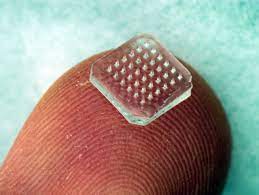By Dominic Taylor-
Scientists in the U.S have been developing a vaccine patch that could be used in the fight against COVID-19.
The Centre for Drug Design, Development and Delivery at Georgia Tech, scientists have been experimenting with a patch that would present an alternative to needles when it comes to vaccines for the likes of flu, measles and even coronavirus.
The ‘microneedle patch’ is designed using a collection of dozens of tiny needles lined up on a small patch. According to the CDC, the ‘needles are so tiny that each one is measured in micrometres and is as thin as a human hair.’
The idea is to provide a safer and more varied alternative to needles, so this could be the first step in the extension of the conventional vaccine.
Now, in the interest of transparency, it’s not like you won’t feel anything at all in comparison to a needle. ‘Like if someone took some Velcro and pressed that firmly against your skin,’ Mark Prausnitz, director at the centre, told NPR.
‘There’s a kind of a roughness. Some people may describe it as a kind of tingling. So there is a sensation, but it’s a sensation that people don’t find objectionable or painful,’ he added.
Vaccine patches are being developed at Georgia Tech. (Gary Meek/Georgia Tech)Gary Meek/Georgia Tech
The new patches have their origin the computer chip industry. ‘They got smaller and smaller and eventually got down to the micron scale, which is what we need to make the microneedle patches,’ Prausnitz said.
Rather than the sometimes complicated measures required to store vaccine vials and the process of injection, ease of delivery is one of the biggest strengths of patches, with the dose encapsulated in the microneedles to be placed onto the skin. ‘It’s much like putting on a Band-Aid, and the pain that comes with current subcutaneous injections is bypassed,’ the CDC explains.
While a needle goes rather deep through your skin, the patch only needs ‘tens of microns in length’ to work, thanks to being able to hit the immune cells on the outermost part of your skin. ‘If you want to get into the body across this barrier layer of the skin, you don’t need something that measures millimetres and then centimetres long, like conventional hypodermic needles,’ Prausnitz
. Darin Zehrung, program leader for medical devices and health technologies at global health organisation PATH, said: ‘What’s needed is the commitment by industry to that as a particular product.’
However, he added: ‘I’m more optimistic than I have been in the past. We’re getting closer.’
Vaccines are widely seen as the safest way to guard against the coronavirus, but they still provide no perfect protection.

